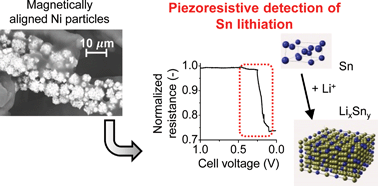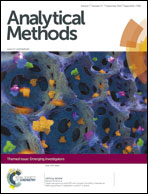A magnetically tuneable piezoresistive sensor for direct, in situ strain measurements in Li-ion batteries†
Abstract
This paper demonstrates the first example of using generic Li-ion battery components (nickel, carboxymethylcellulose and styrene–butadiene rubber) to prepare piezoresistive materials (PRMs) which detect the strain of lithiating Sn in operando. The PRM was prepared by mixing the three components and molding it into a desired shape. Three different types of Ni microparticle arrangement strategies were investigated to study their effects on the piezoresistive performance: an alignment parallel to or perpendicular to the direction of strain, and no alignment (control and random dispersion). The alignment was directed by an external magnetic field during sample preparation and confirmed using cross-sectional SEM images. Significant differences were found between the different alignments, with the parallel alignment resulting in the lowest percolation threshold of 4 vol% Ni and perpendicular alignment the highest of 11 vol% Ni. For a fixed fraction of Ni microparticles at 4 vol%, the difference in alignment resulted in a difference in the gauge factor by three orders of magnitude. The stress–strain curve of the prepared PRMs showed a typical response seen for porous structures, which was consistent with the SEM images. The PRM samples are compatible with the low operating potential and the organic Li-ion electrolyte, and its porous structure allows electrolyte infusion that ensures the ionic conductivity of the material. Lithiation of Sn was successfully detected as a change in resistance using a parallelly aligned PRM with no additional treatment. The method described here offers significant merits over conventional approaches: the ability to directly monitor the strain without complex modelling, the simple low cost setup that does not require specialized equipment, and the ability to easily control the PRM performance by magnetically directed assembly.

- This article is part of the themed collection: Emerging Investigators

 Please wait while we load your content...
Please wait while we load your content...